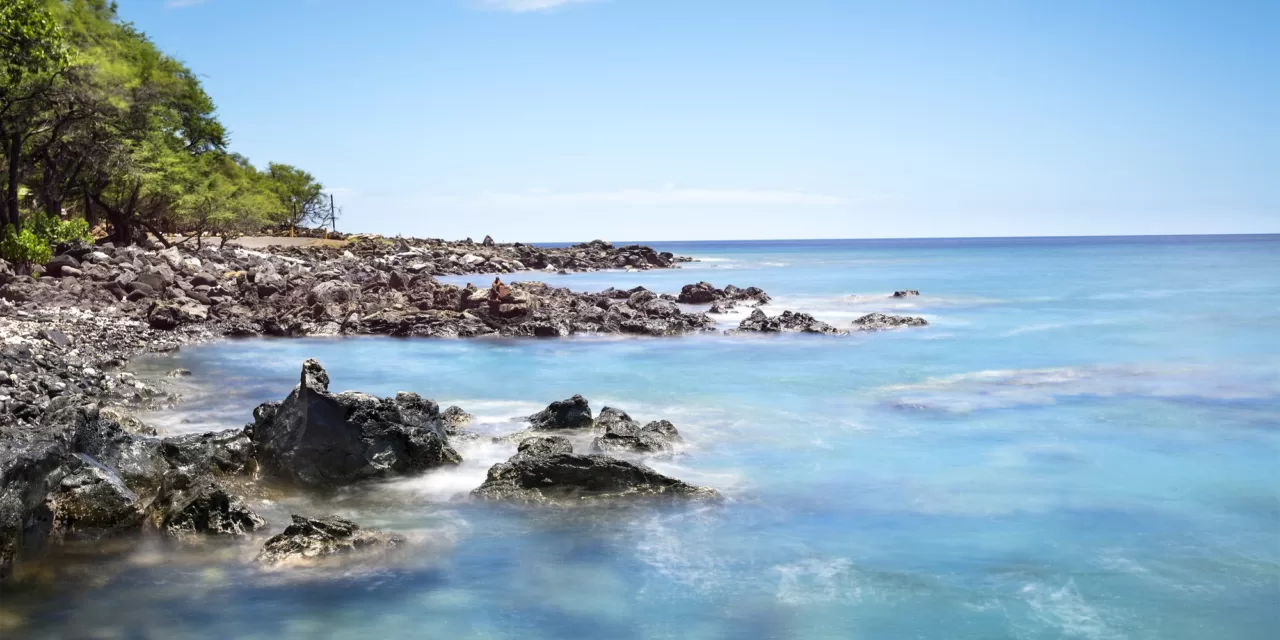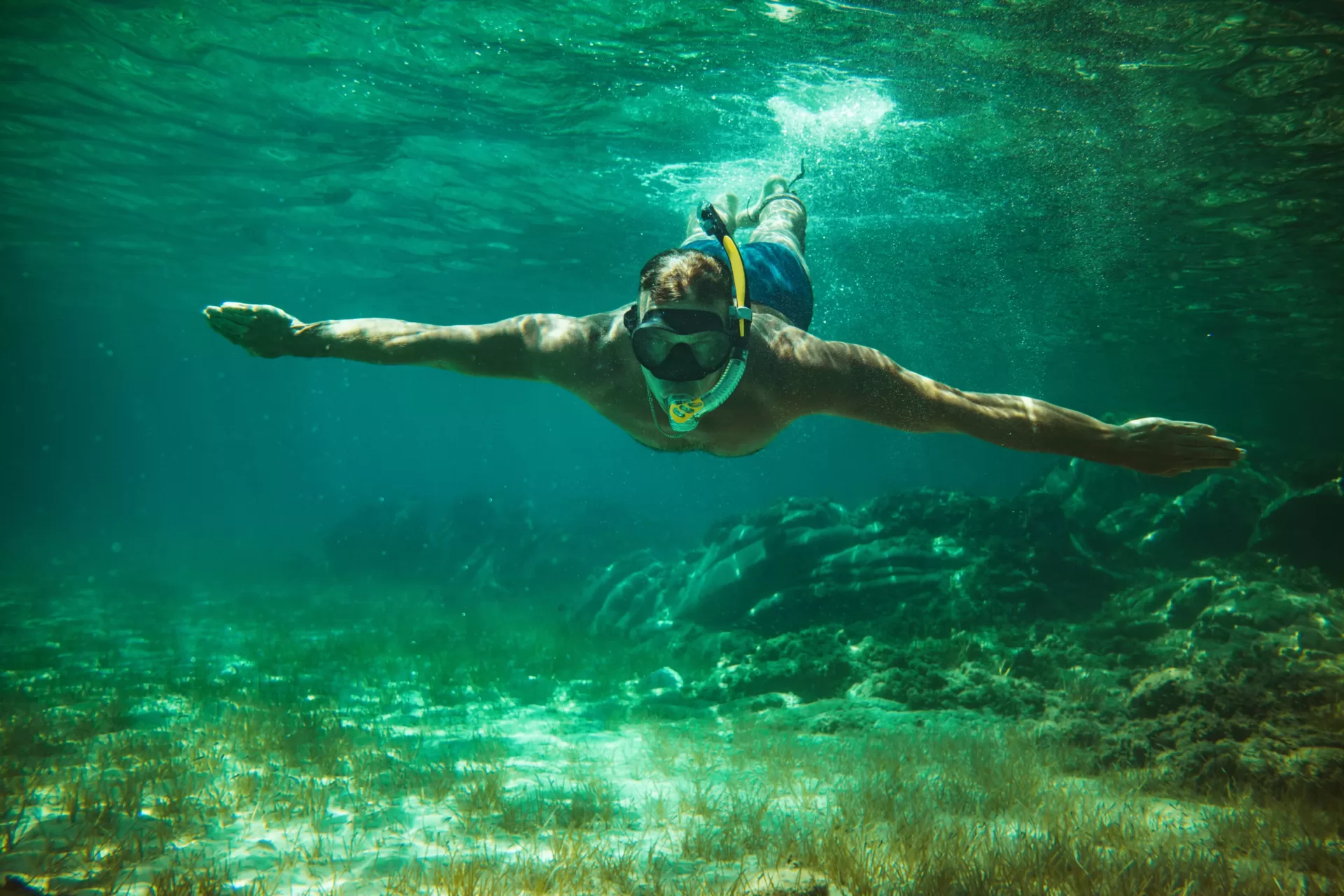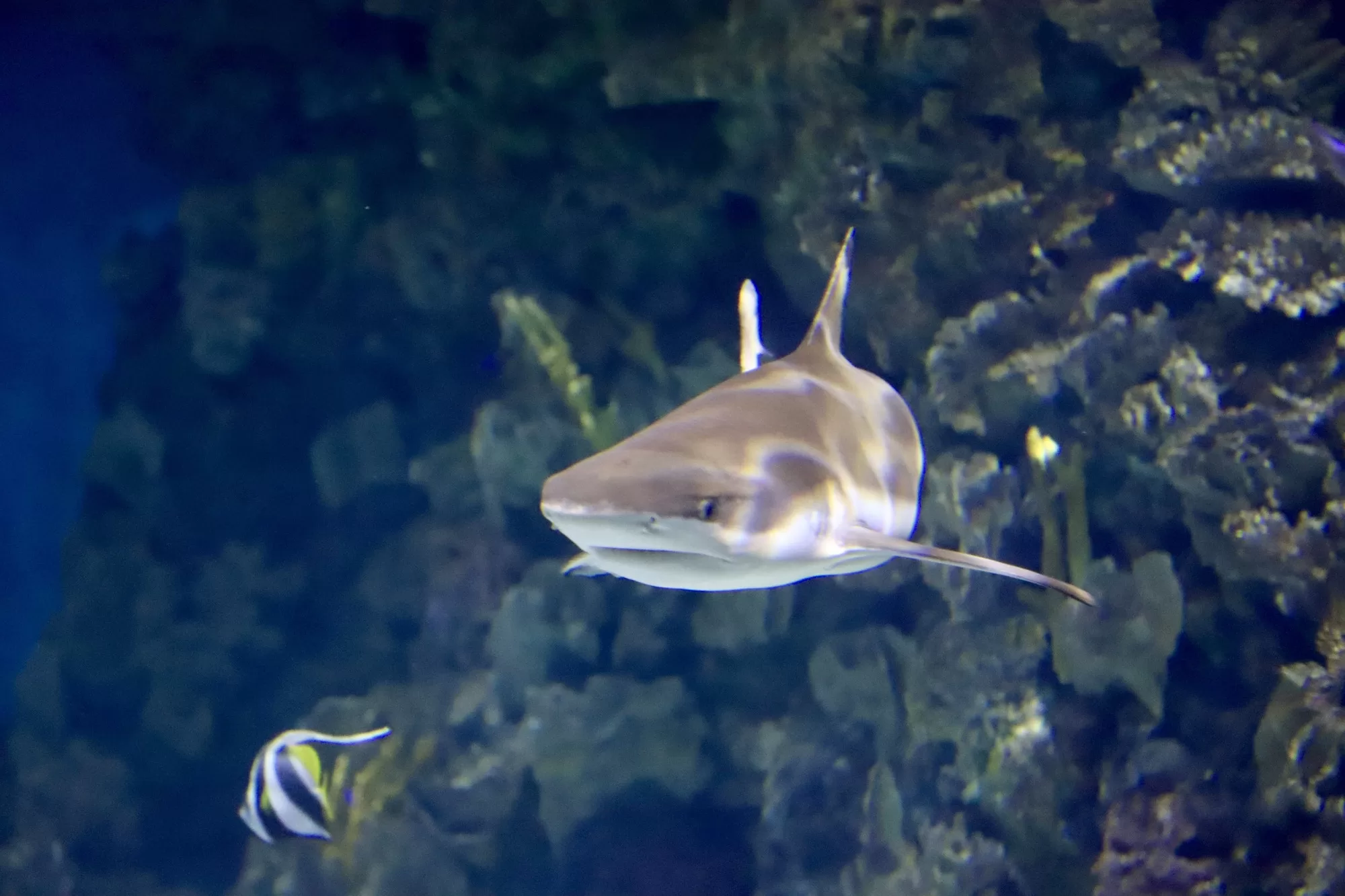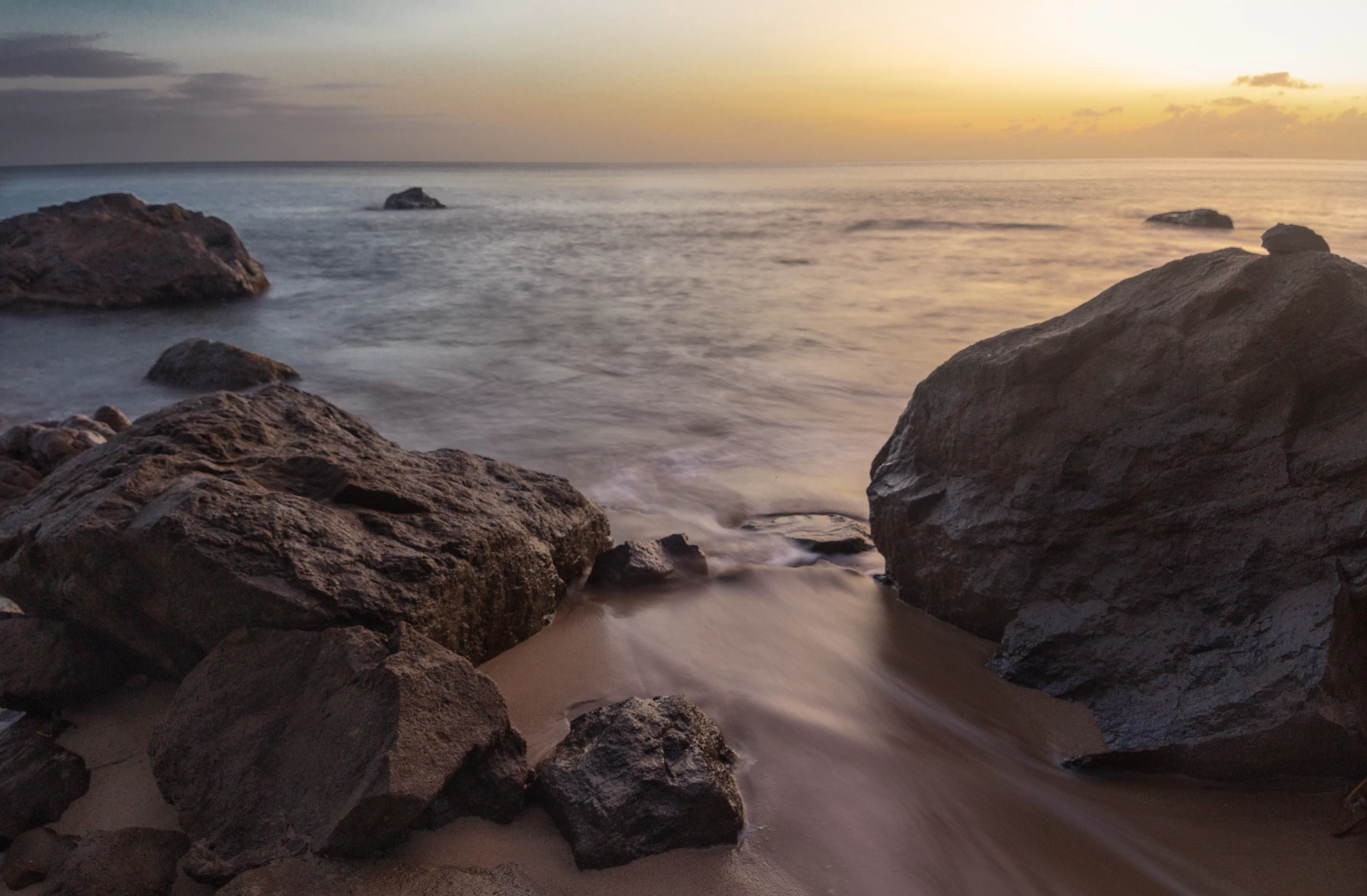Nestled on the western shore of Hawaii’s Big Island, the Kona Coast offers a stunning mosaic of natural beauty both above and below the water. This region, known for its lava-lined coastlines and serene waters, holds a treasure trove of marine life, making it a premier destination for diving enthusiasts around the globe. Diving the Kona Coast isn’t just an activity; it’s an immersion into a world where nature’s artistry is on vivid display beneath the waves.
The significance of diving in this area cannot be overstated. It provides a unique opportunity to explore an underwater landscape shaped by volcanic activity, where hard and soft corals thrive alongside a diverse array of marine species. The Kona Coast’s waters are a gateway to understanding and appreciating the complex ecosystems that exist beneath the ocean’s surface, offering both adventure and enlightenment to those who dive into its depths.
Why Dive the Kona Coast?
Unique Marine Biodiversity
The Kona Coast is a haven for marine biodiversity, thanks to its isolated location in the Pacific and the nutrient-rich waters that flow from the deep ocean up onto its shores. Divers can expect to encounter a wide array of marine life, from the smallest, most colorful reef fish to large pelagic species. The area is famous for its encounters with manta rays, spinner dolphins, and during the right season, humpback whales. This rich biodiversity not only makes every dive an unpredictable adventure but also a learning experience about the variety of life in our oceans.
Crystal Clear Waters and Excellent Visibility
One of the most remarkable features of the Kona Coast is its crystal clear waters, providing exceptional visibility often exceeding 100 feet (30 meters). This clarity is a result of the volcanic rock that filters the water along the coast, combined with the minimal runoff from the land. Such conditions make it an ideal spot for underwater photography and videography, allowing divers to capture the vibrant marine life and intricate coral formations in stunning detail. The clear waters also enhance safety and navigation during dives, making it easier for divers to explore and enjoy their surroundings.
Year-Round Diving Opportunities
The Kona Coast offers favorable diving conditions throughout the year, making it a rare gem for divers who seek flexibility in their travel plans. The water temperature remains relatively constant, ranging from 75°F (24°C) in the winter months to 80°F (27°C) during the summer, ensuring a comfortable dive experience any time of the year. Additionally, the region is protected from the trade winds by the massive Mauna Loa volcano, resulting in calm sea conditions and minimal currents. This year-round accessibility allows divers to experience the wonders of the Kona Coast at their convenience, whether they’re looking to swim with the manta rays under the moonlight or explore the vibrant coral reefs that flourish in these waters.
Preparing for Your Dive Adventure
Embarking on a dive adventure to the Kona Coast promises an unforgettable journey into the underwater world. To ensure a seamless experience, it’s important to plan meticulously, from choosing the best time to visit to understanding what to pack. Here’s how to prepare for your dive adventure on the Kona Coast.
Best Times to Visit for Diving
While the Kona Coast offers year-round diving opportunities, certain times of the year can enhance your diving experience depending on your interests. For those eager to witness the majestic manta rays, night diving trips are available throughout the year, with high sightings often reported. However, the peak season for overall marine life activity, including the chance to see humpback whales, is during the winter months from December to March. This period offers divers the unique opportunity to hear the hauntingly beautiful whale songs while exploring the depths.
The summer months, from May to September, provide the warmest water temperatures and calmest sea conditions, ideal for beginners or those looking to explore the more remote dive sites comfortably. Visibility is excellent during these months, making it a great time for underwater photography.
Required Diving Qualifications and Experience
Diving the Kona Coast is accessible to divers of all levels, from beginners to advanced. However, certain dive sites may require specific qualifications due to depth, currents, or the need for night diving capabilities. It’s essential to have an Open Water Diver certification as a minimum for most dives. For more advanced sites or night dives, especially to see the manta rays, an Advanced Open Water Diver certification or proof of experience might be necessary.
Dive operators in Kona are committed to safety and will require a check dive if you haven’t been diving recently. This ensures comfort and safety for all divers, allowing everyone to enjoy their underwater adventure to the fullest.
What to Pack for Your Trip
Packing for a diving trip involves more than just your usual travel essentials. Here are some key items to bring along:
- Dive Certification Card and Logbook: Essential for booking dives and proving your experience level.
- Diving Gear: While most dive shops offer rental equipment, you may want to bring your personal gear, such as a mask, snorkel, and fins, for comfort and fit. Consider packing a dive computer, underwater camera, and a waterproof flashlight for night dives.
- Reef-Safe Sunscreen: Protect your skin without harming the marine ecosystem with a biodegradable, reef-safe sunscreen.
- Rash Guard or Wetsuit: A rash guard for sun protection or a 3mm wetsuit is typically sufficient for Kona’s warm waters.
- Dry Bag: Keep your electronics and valuables dry while on the boat.
- Hydration and Snacks: Staying hydrated is crucial. Bring a reusable water bottle and some snacks for energy between dives.
Preparing for your dive trip to the Kona Coast is about ensuring you have the right qualifications, knowing the best time to visit, and packing wisely. With these considerations in mind, you’re set for a diving adventure in one of the most beautiful underwater destinations in the world.
Top Dive Sites Along the Kona Coast
The Kona Coast is dotted with exceptional dive sites, each offering its unique underwater landscapes and marine life. From the enchanting Manta Ray Night Dive to the historical depths of the Captain Cook Monument, here’s a guide to the must-visit dive sites along the Kona Coast.
Manta Ray Night Dive
The Manta Ray Night Dive is perhaps the most famous dive in Hawaii, offering a surreal experience that’s unmatched anywhere in the world. Divers and snorkelers gather at sites like Garden Eel Cove after sunset, where lights are used to attract plankton, which in turn attracts the majestic manta rays. These gentle giants, with wingspans up to 15 feet, perform graceful ballets just inches from divers. It’s a magical encounter that leaves a lasting impression on all who experience it.
Coral Gardens
The Coral Gardens offer a vibrant display of marine biodiversity, nestled at a relatively shallow depth of 25 to 35 feet. This site is perfect for divers of all levels, including beginners. The array of hard and soft corals forms a colorful backdrop for the diverse species of tropical fish, moray eels, and occasional sea turtles that call this garden home. The calm conditions and shallow depth make it an excellent site for underwater photography.
The Dome
The Dome, named for its unique geological structure, is a submerged volcanic crater that creates an amphitheater-like environment underwater. Divers can explore the crater’s rim and venture into its open ceiling cave, where light filters through, creating a serene ambiance. This site is known for its stunning coral formations and the variety of fish that weave through its crevices. The Dome offers a mix of exploration for both intermediate and advanced divers.
Captain Cook Monument
Located in Kealakekua Bay, the Captain Cook Monument dive site is both a historical landmark and a marine sanctuary. The waters here are protected, leading to an abundance of marine life and healthy coral ecosystems. The site is accessible by boat and offers divers the chance to explore steep drop-offs, caves, and archways teeming with colorful fish, spinner dolphins, and sometimes even Hawaiian monk seals. The clear waters provide excellent visibility, making it a favorite among underwater photographers.
Garden Eel Cove
Garden Eel Cove, also the site for the Manta Ray Night Dive, is notable for its daytime diving as well. During the day, the sandy bottom becomes a field of garden eels, swaying gently with the current as they feed on passing plankton. This site offers a unique spectacle and is also known for sightings of eagle rays, barracudas, and the occasional shark. The mix of sandy bottom and nearby coral reefs provides a diverse habitat for marine life and a fascinating dive experience.
Each of these top dive sites along the Kona Coast offers something unique, whether you’re looking to interact with the majestic manta rays, explore vibrant coral ecosystems, or dive into the history and natural beauty of Hawaii’s underwater world.
Marine Life You’ll Encounter
Diving the Kona Coast is like entering a different world, one filled with an astonishing variety of marine life. From the iconic manta rays to vibrant coral reefs teeming with tropical fish, each dive offers a unique opportunity to observe and interact with the ocean’s inhabitants.
Manta Rays: The Gentle Giants of the Sea
Manta rays are undoubtedly the stars of the Kona Coast. These magnificent creatures, with wingspans that can reach up to 15 feet, are known for their gentle nature and gracefulness. Encountering a manta ray up close, especially during a night dive, is an unforgettable experience. They glide through the water with effortless elegance, often coming within inches of divers as they feed on the plankton attracted by dive lights.
Tropical Fish and Colorful Coral Reefs
The coral reefs along the Kona Coast are vibrant ecosystems, home to hundreds of species of tropical fish. Divers can expect to see a kaleidoscope of colors and activity, from the smallest, intricately patterned reef fish to larger species like the triggerfish and parrotfish. The diversity of corals, from brain corals to fan corals, provides a stunning backdrop to the bustling life of the reef, creating a dynamic underwater landscape that changes with every dive.
Rare Sightings: Dolphins, Whales, and Sharks
While manta rays and colorful reef fish are common sights, the Kona Coast also offers the chance for some rare and exciting encounters. Pods of spinner dolphins are often seen, especially in the early mornings, displaying their acrobatic flips and spins. During the winter months, humpback whales can be heard and sometimes seen as they migrate through the Hawaiian waters. For those seeking a thrill, there’s also the possibility of encountering sharks, including the white tip reef shark, known for its curiosity towards divers.
Tips for a Successful Dive
To ensure a memorable and safe diving experience on the Kona Coast, here are some essential tips covering safety protocols, choosing the right dive operator, and deciding between renting equipment or bringing your own.
Safety Protocols and Environmental Conservation
Safety and environmental conservation go hand in hand. Always follow safe diving practices, such as never touching or stepping on the coral and maintaining proper buoyancy control to avoid damaging the delicate reef ecosystems. Be mindful of the marine life, observing from a distance without disturbing their natural behaviors. Additionally, participating in briefings by your dive operator about local regulations and conservation efforts is crucial.
Choosing the Right Dive Operator
Selecting a reputable dive operator is key to a successful dive experience. Look for operators with certified and experienced guides who prioritize safety and environmental conservation. It’s also beneficial to choose operators who offer small group sizes, ensuring personalized attention and a less crowded dive. Researching reviews and asking for recommendations can help you find a dive operator that matches your expectations and values.
Equipment Rental vs. Bringing Your Own Gear
Deciding whether to rent diving equipment or bring your own gear depends on several factors, including convenience, comfort, and cost. Renting gear from a local dive shop is a hassle-free option that eliminates the need to travel with bulky equipment. However, if you have gear that fits well and you’re comfortable using, bringing your own can enhance your dive experience. Many dive operators offer a mix of both options, allowing you to rent certain pieces while bringing your essentials, like a well-fitting mask or dive computer.
Beyond Diving: What Else to Do on the Kona Coast
The Kona Coast is not only a diver’s paradise but also a destination rich with surface-level adventures, cultural depth, and culinary delights. Whether you’re taking a day off from diving or traveling with companions who prefer to stay dry, there’s no shortage of activities to explore.
Snorkeling Spots for Non-Divers
Snorkeling is a fantastic way to experience the Kona Coast’s marine life without the need for a dive certification. Kahalu’u Beach Park is one of the most accessible spots, offering calm waters and a chance to swim with sea turtles among the coral. Honaunau Bay, near the City of Refuge, is another excellent location where the clear waters provide a window to a vibrant underwater world, perfect for all ages.
Cultural and Historical Sites
The Kona Coast is steeped in Hawaiian history and culture. The Pu’uhonua o Honaunau National Historical Park, also known as the City of Refuge, offers a glimpse into ancient Hawaiian culture and traditions. Here, visitors can explore sacred temples, royal grounds, and beautifully carved wooden statues. Another must-visit is the Kona Coffee Living History Farm, where you can learn about the region’s coffee heritage and sample some of the world’s best coffee.
Local Cuisine and Dining Experiences
Kona’s dining scene is a reflection of its diverse culture, offering everything from traditional Hawaiian dishes to international cuisine. Don’t miss the opportunity to attend a luau, where you can experience local specialties like kalua pork, poke, and poi, along with live music and hula dancing. The Kona Farmers Market is the perfect place to sample fresh tropical fruits, local honey, and artisanal products. For coffee enthusiasts, a visit to a coffee plantation to taste Kona coffee in its birthplace is a must.
Practical Information for Travelers
To make the most of your trip to the Kona Coast, here are some practical tips regarding travel logistics, accommodation, and getting around.
Getting to the Kona Coast
The Kona International Airport (KOA) serves as the primary gateway for visitors to the west side of the Big Island. It hosts interisland flights as well as direct flights from the mainland USA and Canada, making it relatively easy to reach this diving haven.
Accommodation Options: From Budget to Luxury
The Kona Coast offers a wide range of accommodation options to suit every budget and preference. Budget travelers can find comfortable hostels and guesthouses, while mid-range options include hotels and vacation rentals with ocean views. For those seeking luxury, the coast is dotted with high-end resorts offering exquisite rooms, spa services, and golf courses, all designed to provide the ultimate island retreat.
Renting a car is the most convenient way to explore the Kona Coast and the wider Big Island, giving you the freedom to visit dive sites, beaches, and attractions at your own pace. Public transportation exists but is limited in coverage and frequency, making it less practical for tourists. For those planning to stick to a specific area, taxis and ride-sharing services are available for shorter trips.
The Kona Coast offers a mix of underwater adventure, cultural richness, and natural beauty, making it an ideal destination for travelers seeking a comprehensive Hawaiian experience. Whether you’re here to dive into the depths or explore the land’s surface, the Kona Coast promises an unforgettable journey.
Frequently Asked Questions
1. Do I need a diving certification to dive on the Kona Coast?
Yes, you need at least an Open Water Diver certification to participate in most dive activities. Some advanced sites may require higher certification levels or proof of recent diving experience.
2. Are there any dive sites suitable for children on the Kona Coast?
Yes, there are snorkeling and shallow diving spots like Kahalu’u Beach Park that are suitable for children and beginner divers. Always ensure children are accompanied by a certified adult diver or instructor.
3. How do I choose a dive operator on the Kona Coast?
Look for operators with positive reviews, certified and experienced guides, and a commitment to safety and environmental conservation. It’s also a good idea to compare the types of dive experiences they offer to match your interests and skill level.
4. What kind of marine life can I expect to see on the Kona Coast?
Expect to see a rich variety of marine life including manta rays, colorful tropical fish, sea turtles, dolphins, and during certain seasons, humpback whales. The area’s coral reefs are also home to numerous small marine creatures.
5. What are the water temperatures like for diving on the Kona Coast?
Water temperatures vary from about 75°F (24°C) in the winter to 80°F (27°C) in the summer, making for comfortable diving conditions year-round.
6. Can non-divers enjoy the Kona Coast?
Absolutely! Non-divers can enjoy snorkeling, swimming, and boat tours that offer dolphin and whale watching opportunities. The Kona Coast also offers beautiful beaches, hiking trails, and cultural sites.
7. What is the best time of day for diving on the Kona Coast?
While daytime diving is spectacular for visibility and exploring coral reefs, the manta ray night dives offer a unique and unforgettable experience. The best time depends on what you wish to see and experience.
8. Is it better to rent diving equipment or bring my own to the Kona Coast?
It depends on your preference and travel logistics. Renting equipment can be convenient and ensures you have gear suited to local conditions, but using your own gear may be more comfortable if you’re particular about fit and performance.
9. Are there any health and safety tips I should be aware of before diving on the Kona Coast?
Ensure you’re in good physical health, stay hydrated, and protect yourself from the sun. Be aware of local diving conditions and follow all safety instructions provided by your dive operator. It’s also a good idea to have dive insurance.
10. How can I participate in marine conservation efforts while diving on the Kona Coast?
Many dive operators offer eco-diving experiences and participate in reef conservation projects. You can join these efforts, adopt responsible diving practices, and support local conservation organizations through donations or volunteer work.
Start Your Adventure
Exploring the underwater beauty of the Kona Coast offers a remarkable adventure that’s as enriching as it is exciting. Whether you’re witnessing the graceful dance of manta rays or marveling at the intricate ecosystems of coral reefs, diving here connects you with the ocean in profound ways. By preparing well and choosing responsible diving practices, you can ensure your dive adventure is not only memorable but also contributes positively to the preservation of this magnificent marine environment.
Ready to dive into the breathtaking waters of the Kona Coast? Start planning your trip today! Choose a certified dive operator, pack your bags with the ocean in mind, and get ready for an unforgettable underwater journey. And remember, every dive is an opportunity to be a steward of the sea, so let’s dive responsibly and protect the marine life that makes the Kona Coast so special. Share your experiences and inspire others to join in the effort to conserve Hawaii’s underwater paradise for future generations to explore and enjoy.




